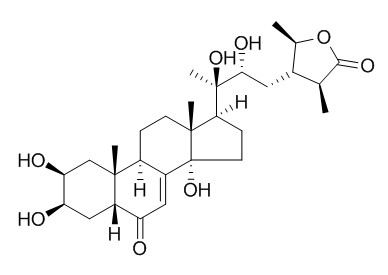Cyasterone
Cyasterone, a natural EGFR inhibitor, can inhibit growth of A549 and MGC823 cells, via regulating EGFR signaling pathway, it maybe a promising anti-cancer agent; it also has antifeeding activity.
Inquire / Order:
manager@chemfaces.com
Technical Inquiries:
service@chemfaces.com
Tel:
+86-27-84237783
Fax:
+86-27-84254680
Address:
1 Building, No. 83, CheCheng Rd., Wuhan Economic and Technological Development Zone, Wuhan, Hubei 430056, PRC
Providing storage is as stated on the product vial and the vial is kept tightly sealed, the product can be stored for up to
24 months(2-8C).
Wherever possible, you should prepare and use solutions on the same day. However, if you need to make up stock solutions in advance, we recommend that you store the solution as aliquots in tightly sealed vials at -20C. Generally, these will be useable for up to two weeks. Before use, and prior to opening the vial we recommend that you allow your product to equilibrate to room temperature for at least 1 hour.
Need more advice on solubility, usage and handling? Please email to: service@chemfaces.com
The packaging of the product may have turned upside down during transportation, resulting in the natural compounds adhering to the neck or cap of the vial. take the vial out of its packaging and gently shake to let the compounds fall to the bottom of the vial. for liquid products, centrifuge at 200-500 RPM to gather the liquid at the bottom of the vial. try to avoid loss or contamination during handling.
Sci Rep.2018, 8(1):12970
Foods.2020, 9(10):1348.
Cosmetics2021, 8(3),91.
Pharmaceuticals (Basel).2020, 13(9):262.
J Ethnopharmacol.2017, 198:87-90
Journal of Molecular Liquids2022, 364:120062.
Mol Cells.2018, 41(8):771-780
J Ethnopharmacol.2020, 249:112396
Int Immunopharmacol.2020, 90:107268.
Auburn University2015, 1-58
Related and Featured Products
Insect Sci., 2001, 8(3):233-9.
Effects of cyasterone on growth and development of diamondback moth, Plutella xylostella (L.)[Reference:
WebLink]
Cyasterone is the main phytoecdysteroid component from cultured plants of Ajuga nipponensis, and common in other Ajuga species.
METHODS AND RESULTS:
Results showed that when treated with 50 mg/L Cyasterone, the egg hatching of diamondback moth was retarded. The total percentage of eggs hatched in treatment was 94.7%, significantly less than that in control, which was 100%. Low toxicity and good antifeeding activity to the 3rd instar larvae were exhibited, which are dependent upon concentration. The growth and development of diamondback moth were affected by Cyasterone. It was found that, at concentrations higher than 50 mg/L Cyasterone, the larval growth and egg production were inhibited; while promoted at lower concentrations.
CONCLUSIONS:
This dual role of Cyasterone might be attributed to its hormonal activity and antifeeding activity, which resulted in poor nutrition. The pupation and eclosion were hindered by treatment of larvae. This insect species was more susceptible to Cyasterone than 20-hydroxyecdysone.
Biomed. Pharmacother., 2016, 84:330-9.
Anti-proliferation effects, efficacy of cyasterone in vitro and in vivo and its mechanism.[Pubmed:
27668532 ]
Cyasterone was demonstrated potential inhibition effect in mouse skin carcinoma cells in published report. However, the molecular mechanisms of the Cyasterone on cells remain unknown.
METHODS AND RESULTS:
Herein, we investigated the effects of Cyasterone-induced apoptosis in A549 and MGC823 cells in vitro. MTT assay showed that Cyasterone caused a significantly decreasing of the proliferation of A549 and MGC823 cells in a time-and dose-dependent manner with IC50 values of 38.50±3.73μg/mL on A549 cells and 32.96±1.24μg/mL on MGC823 cells at 48h, respectively. Hoechst staining and TUNEL staining results indicated the quintessential apoptosis features in immunofluorescence image. Apoptosis and cell cycle were determined by flow cytometry. Cyasterone treatment triggered inhibition of epidermal growth factor receptor- phosphatidylinositol 3 kinase/protein kinase B (EGFR-AKT) signaling pathways and activation of P38 pathways. Furthermore, Cyasterone inhibited MGC823 cells xenografted tumor growth in vivo with few changes in body weights.
CONCLUSIONS:
In conclusion, our findings provide the evidence that Cyasterone inhibits growth of A549 and MGC823 cells, via regulating EGFR signaling pathway. Our results indicated that Cyasterone, a natural EGFR inhibitor, maybe a promising anti-cancer agent.
J Org Chem. 2014 Jun 20;79(12):5471-7.
Stereochemical assignment of C-24 and C-25 of amarasterone A, a putative biosynthetic intermediate of cyasterone.[Pubmed:
24824008 ]
A C29 phytoecdysteroid named amarasterone A (1) has been isolated from Cyathula capitata (Amaranthaceae), Leuzea carthamoides (Asteraceae), and Microsorum scolopendria (Polypodiaceae).
We recently isolated amarasterone A from C. officinalis. Amarasterone A has been postulated as a biosynthetic intermediate of Cyasterone in Cyathula sp.
METHODS AND RESULTS:
The stereochemistry at the C-24 and C-25 positions of these amarasterone A samples was investigated by comparing the NMR spectroscopic data with those of stereodefined model compounds, (24R,25S)-, (24R,25R)-, (24S,25S)-, and (24S,25R)-isomers of (20R,22R)-3β-methoxystigmast-5-ene-20,22,26-triol (2a-d), which were synthesized in the present study. Amarasterone A isolated from Cyathula officinalis was determined to be the (24R,25S)-isomer (1a), while amarasterone A from L. carthamoides was found to be the (24R,25R)-isomer (1b).
Amarasterone A from M. scolopendria was found to be a mixture of 1a and 1b.
CONCLUSIONS:
The biosynthesis of Cyasterone in Cyathula sp. is discussed on the basis of the identical C-24 configuration of sitosterol and amarasterone A.



